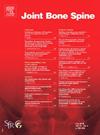Hospital and patient factors predict length of stay in patients with osteoarthritis undergoing total primary hip replacement
IF 3.8
3区 医学
Q1 RHEUMATOLOGY
引用次数: 0
Abstract
Objectives
Over 450,000 primary total hip arthroplasties (THA) are performed each year in the US, with osteoarthritis (OA) as the major indication for primary THA. We examined the association of patient, payer, hospital, and geographic factors with extended lengths of stay (eLOS) and increased hospital costs in primary THA.
Methods
We utilized the National Inpatient Sample (NIS) to identify patients with OA who underwent primary THA in 2019. Diagnoses and procedures were identified using the International Classification of Disease (ICD-10) codes. We stratified healthcare/resource utilization by the occurrence of an extended length of hospital stay (eLOS) at 90th percentile or higher, i.e., > 3 days. We used univariate and multivariable-adjusted logistic regression analyses to assess whether patient, payer, hospital, and geographic factors associated with an eLOS. Predictive probabilities from multivariable analyses were used in area under the curve (AUC) analysis.
Results
There were 1,525,730 primary THAs performed for patients with OA during 2016–2019. Patient race and ethnicity, Medicaid or Medicare payer status, income, age/sex and nearly all regional, and hospital, characteristics were independently associated with eLOS (> 3 days; ROC C-statistic = 0.78).
Conclusion
Patient race and ethnicity and insurance payer status are important patient-level determinants of longer LOS for primary THA hospitalizations in the US. Well-known geographical and hospital-level factors are negatively associated with the hospitalization stay duration outcomes of primary THA in patients with OA. Policy and other interventions targeting these factors may help reduce inpatient healthcare utilization for primary THA.
医院和患者因素预测骨关节炎患者接受全髋关节置换术的住院时间。
目的:在美国,每年进行超过45万例原发性全髋关节置换术(THA),骨关节炎(OA)是原发性全髋关节置换术的主要适应症。我们研究了患者、付款人、医院和地理因素与原发性全髋关节置换术中住院时间延长(eLOS)和住院费用增加的关系。方法:我们利用国家住院患者样本(NIS)来识别2019年接受原发性THA的OA患者。使用国际疾病分类(ICD-10)代码确定诊断和程序。我们根据延长住院时间(eLOS)在第90个百分位数或更高的发生率对医疗保健/资源利用进行分层,即100至30天。我们使用单变量和多变量调整逻辑回归分析来评估患者、付款人、医院和地理因素是否与eLOS相关。多变量分析的预测概率用于曲线下面积(AUC)分析。结果:2016-2019年,共有1,525,730例OA患者接受了原发性THA。患者的种族和民族、医疗补助或医疗保险付款人状况、收入、年龄/性别以及几乎所有地区和医院特征与eLOS独立相关(bb10 3天;ROC c统计量= 0.78)。结论:在美国,患者的种族和民族以及保险付款人状况是决定THA住院时间延长的重要因素。众所周知的地理和医院水平因素与OA患者原发性THA的预后呈负相关。针对这些因素的政策和其他干预措施可能有助于减少原发性THA的住院医疗保健利用率。
本文章由计算机程序翻译,如有差异,请以英文原文为准。
求助全文
约1分钟内获得全文
求助全文
来源期刊

Joint Bone Spine
医学-风湿病学
CiteScore
4.50
自引率
11.90%
发文量
184
审稿时长
25 days
期刊介绍:
Bimonthly e-only international journal, Joint Bone Spine publishes in English original research articles and all the latest advances that deal with disorders affecting the joints, bones, and spine and, more generally, the entire field of rheumatology.
All submitted manuscripts to the journal are subjected to rigorous peer review by international experts: under no circumstances does the journal guarantee publication before the editorial board makes its final decision. (Surgical techniques and work focusing specifically on orthopedic surgery are not within the scope of the journal.)Joint Bone Spine is indexed in the main international databases and is accessible worldwide through the ScienceDirect and ClinicalKey platforms.
 求助内容:
求助内容: 应助结果提醒方式:
应助结果提醒方式:


